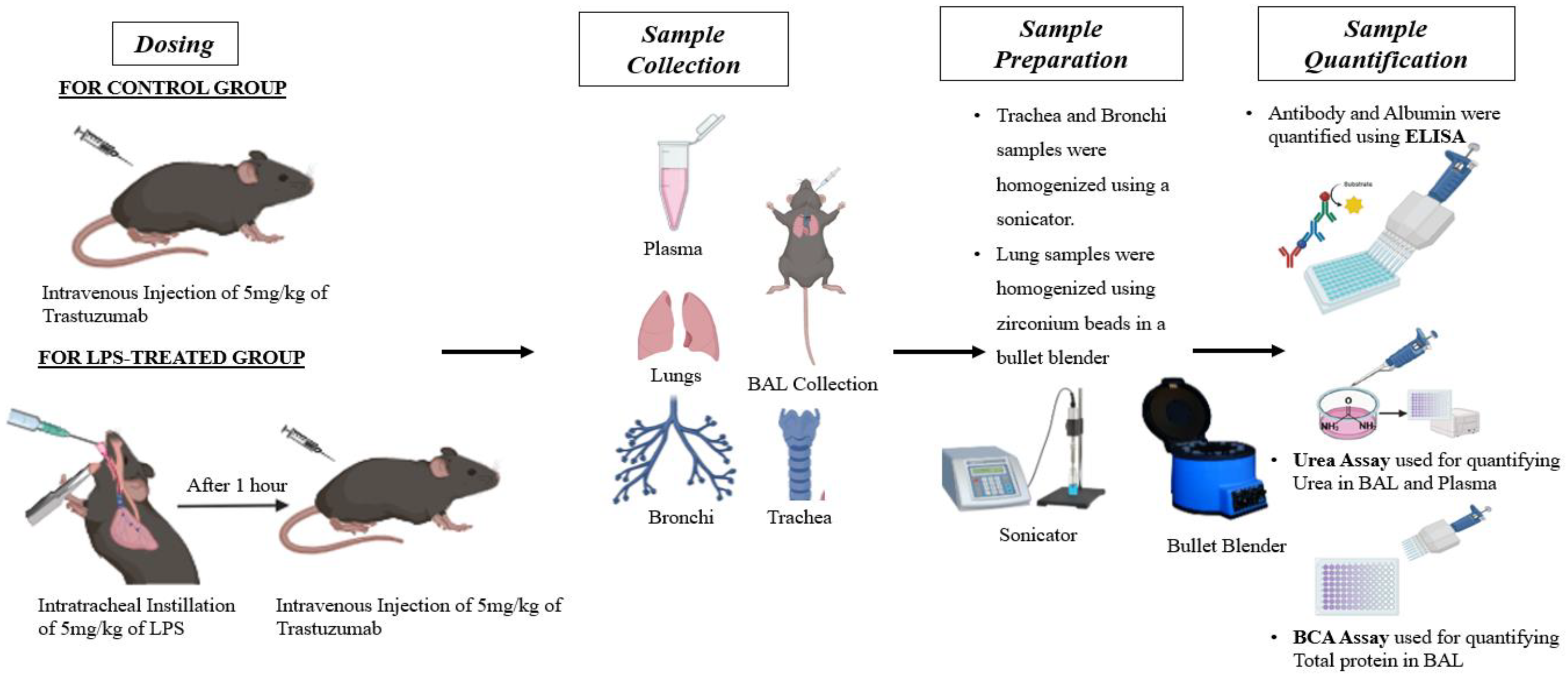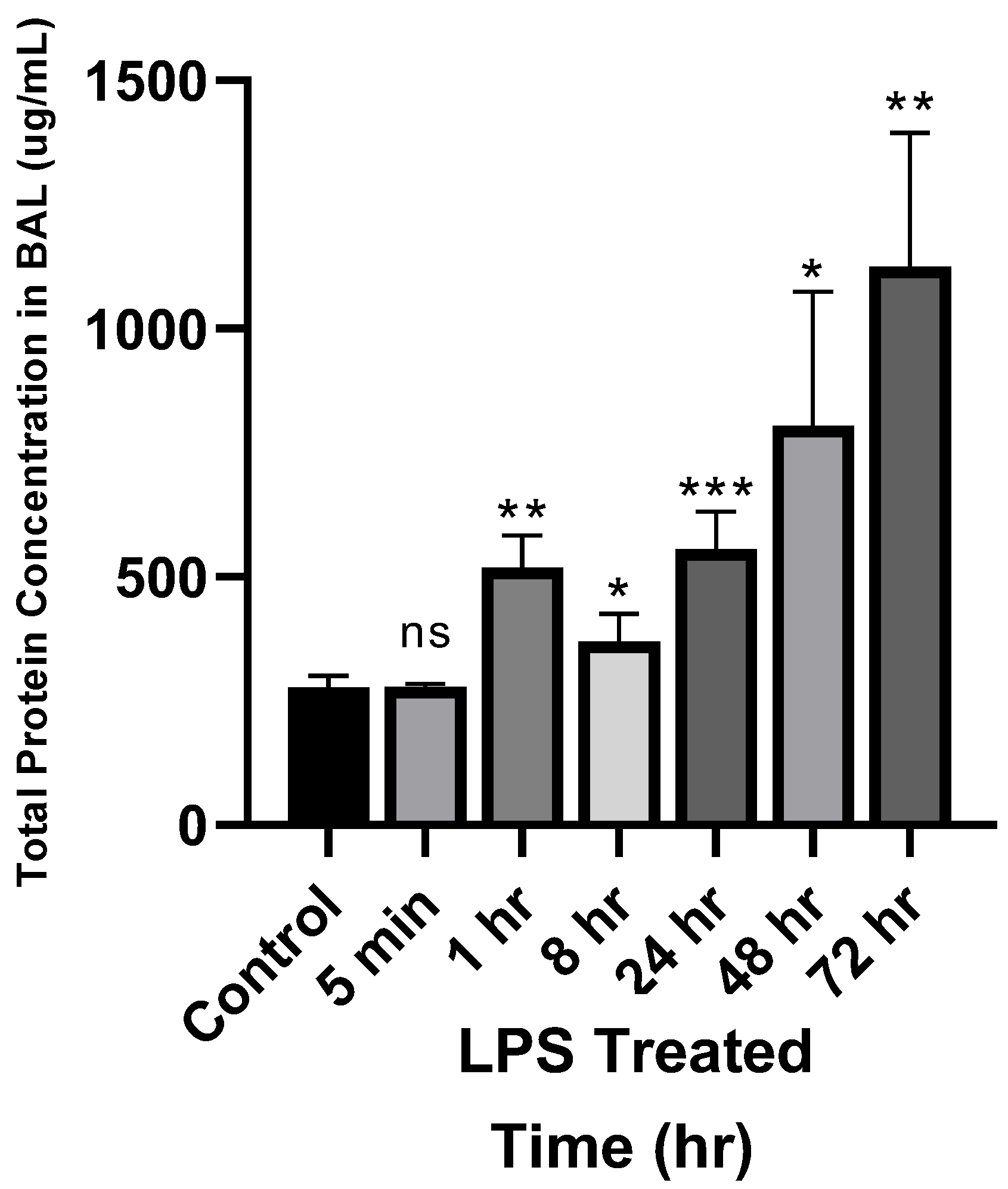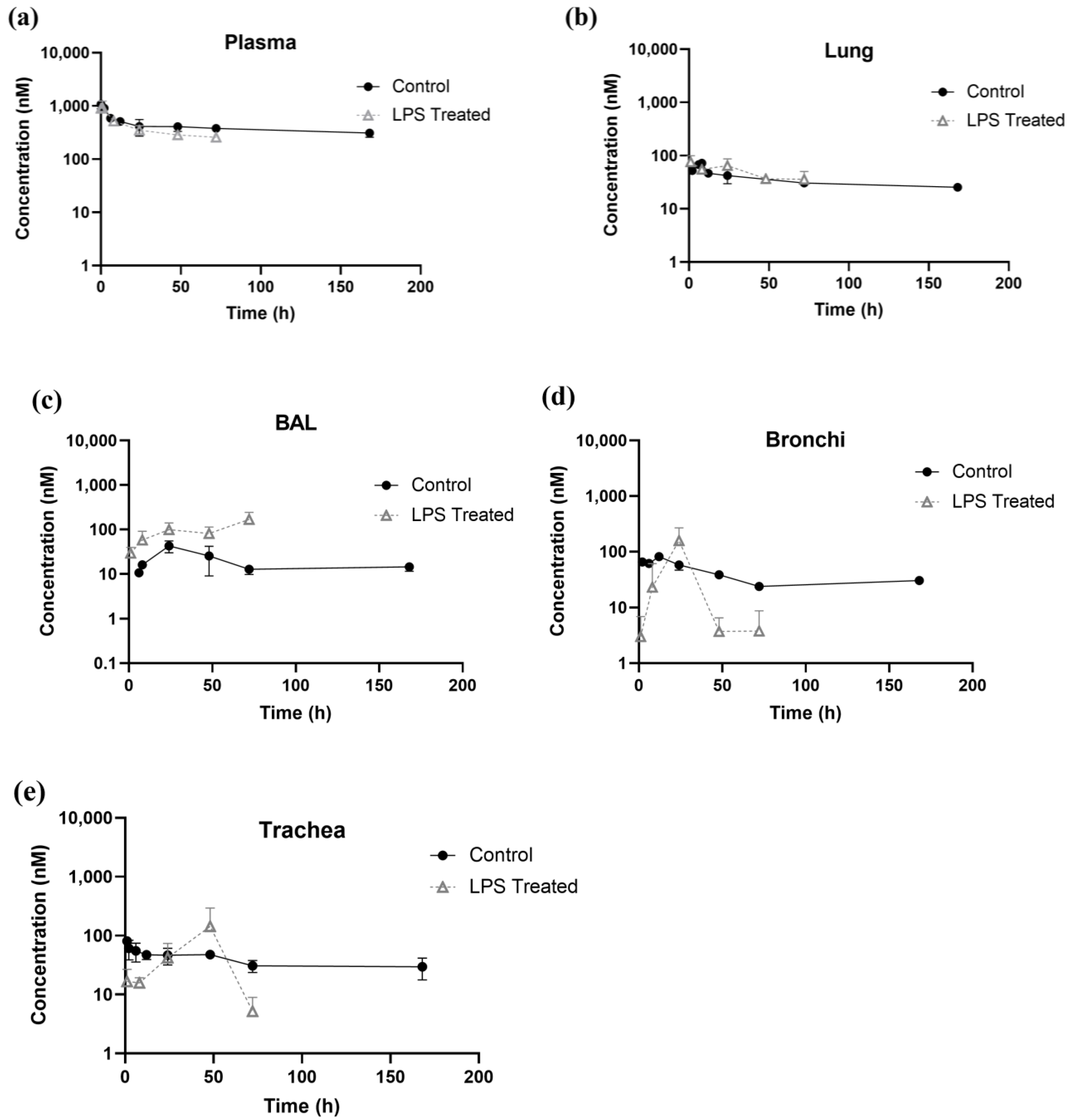Effect of Acute Lung Injury (ALI) Induced by Lipopolysaccharide (LPS) on the Pulmonary Pharmacokinetics of an Antibody
Abstract
1. Introduction
2. Materials and Methods
2.1. Materials
2.2. Protein Production, Purification, and Characterization
2.3. Development of ALI Model
2.4. In Vivo PK Study
2.5. Sample Preparation
2.6. Analytical Method Development
2.6.1. ELISA for Quantification of Antibody
2.6.2. Urea Assay
2.6.3. BCA Total Protein Assay
2.6.4. ELISA for Albumin Quantification
2.7. Statistical Analysis
3. Results
3.1. Antibody Production and Purification
3.2. Development of Analytical Methods (i.e., ELISA, Urea Assay, and BCA Assay) for Quantification of Proteins
3.3. Effect of LPS-Induced ALI on Albumin and Total Protein Levels in BAL
3.4. Effect of LPS-Induced ALI on Systemic and Pulmonary PK of Antibody
3.5. Effect of LPS-Induced ALI on Antibody Biodistribution Coefficient (ABC)
4. Discussion
5. Conclusions
Supplementary Materials
Author Contributions
Funding
Institutional Review Board Statement
Informed Consent Statement
Data Availability Statement
Conflicts of Interest
References
- Bellani, G.; Laffey, J.G.; Pham, T.; Fan, E.; Brochard, L.; Esteban, A.; Gattinoni, L.; van Haren, F.; Larsson, A.; McAuley, D.F.; et al. Epidemiology, Patterns of Care, and Mortality for Patients with Acute Respiratory Distress Syndrome in Intensive Care Units in 50 Countries. JAMA 2016, 315, 788–800. [Google Scholar] [CrossRef] [PubMed]
- Usmani, S.S.; Bedi, G.; Samuel, J.S.; Singh, S.; Kalra, S.; Kumar, P.; Ahuja, A.A.; Sharma, M.; Gautam, A.; Raghava, G.P.S. THPdb: Database of FDA-Approved Peptide and Protein Therapeutics. PLoS ONE 2017, 12, e0181748. [Google Scholar] [CrossRef]
- Manicone, A.M. Role of the Pulmonary Epithelium and Inflammatory Signals in Acute Lung Injury. Expert Rev. Clin. Immunol. 2009, 5, 63–75. [Google Scholar] [CrossRef] [PubMed]
- Cross, L.J.M.; Matthay, M.A. Biomarkers in Acute Lung Injury: Insights into the Pathogenesis of Acute Lung Injury. Crit. Care Clin. 2011, 27, 355–377. [Google Scholar] [CrossRef]
- Ware, L.B.; Matthay, M.A. The Acute Respiratory Distress Syndrome. N. Engl. J. Med. 2000, 342, 1334–1349. [Google Scholar] [CrossRef]
- Righetti, R.F.; Santos, T.M.D.; Camargo, L.D.N.; Aristóteles, L.R.C.R.B.; Fukuzaki, S.; Souza, F.C.R.D.; Santana, F.P.R.; Agrela, M.V.R.D.; Cruz, M.M.; Alonso-Vale, M.I.C.; et al. Protective Effects of Anti-IL17 on Acute Lung Injury Induced by LPS in Mice. Front. Pharmacol. 2018, 9, 1021. [Google Scholar] [CrossRef]
- Lee, I.; Dodia, C.; Chatterjee, S.; Feinstein, S.I.; Fisher, A.B. Protection against LPS-Induced Acute Lung Injury by a Mechanism-Based Inhibitor of NADPH Oxidase (Type 2). Am. J. Physiol.-Lung Cell. Mol. Physiol. 2014, 306, L635–L644. [Google Scholar] [CrossRef]
- Huh, J.W.; Kim, W.Y.; Park, Y.Y.; Lim, C.-M.; Koh, Y.; Kim, M.-J.; Hong, S.-B. Anti-Inflammatory Role of Mesenchymal Stem Cells in an Acute Lung Injury Mouse Model. Acute Crit. Care 2018, 33, 154–161. [Google Scholar] [CrossRef]
- Su, Z.-Q.; Mo, Z.-Z.; Liao, J.-B.; Feng, X.-X.; Liang, Y.-Z.; Zhang, X.; Liu, Y.-H.; Chen, X.-Y.; Chen, Z.-W.; Su, Z.-R.; et al. Usnic Acid Protects LPS-Induced Acute Lung Injury in Mice through Attenuating Inflammatory Responses and Oxidative Stress. Int. Immunopharmacol. 2014, 22, 371–378. [Google Scholar] [CrossRef]
- Liang, W.; Pan, H.W.; Vllasaliu, D.; Lam, J.K.W. Pulmonary Delivery of Biological Drugs. Pharmaceutics 2020, 12, 1025. [Google Scholar] [CrossRef]
- Deb, P.; Molla, M.M.A.; Saif-Ur-Rahman, K.M. An Update to Monoclonal Antibody as Therapeutic Option against COVID-19. Biosaf. Health 2021, 3, 87–91. [Google Scholar] [CrossRef] [PubMed]
- Matthews, A.A.; Ee, P.L.R.; Ge, R. Developing Inhaled Protein Therapeutics for Lung Diseases. Mol. Biomed. 2020, 1, 11. [Google Scholar] [CrossRef] [PubMed]
- Jagdale, P.; Verma, A.; Shah, D.K. Pulmonary Pharmacokinetics of Antibody and Antibody Fragments Following Systemic and Local Administration in Mice. Pharmaceutics 2024, 16, 1259. [Google Scholar] [CrossRef]
- Leonard, A.; Grose, V.; Paton, A.W.; Paton, J.C.; Yule, D.I.; Rahman, A.; Fazal, F. Selective Inactivation of Intracellular BiP/GRP78 Attenuates Endothelial Inflammation and Permeability in Acute Lung Injury. Sci. Rep. 2019, 9, 2096. [Google Scholar] [CrossRef]
- Liu, L.; Gao, Z.; Xia, C.; Xu, Y.; Ma, Z.; Dong, C.; Li, B. Comparative Study of Trans-Oral and Trans-Tracheal Intratracheal Instillations in a Murine Model of Acute Lung Injury. Anat. Rec. 2012, 295, 1513–1519. [Google Scholar] [CrossRef]
- Tighe, R.M.; Birukova, A.; Yaeger, M.J.; Reece, S.W.; Gowdy, K.M. Euthanasia- and Lavage-Mediated Effects on Bronchoalveolar Measures of Lung Injury and Inflammation. Am. J. Respir. Cell Mol. Biol. 2018, 59, 257–266. [Google Scholar] [CrossRef]
- Tsikis, S.T.; Fligor, S.C.; Hirsch, T.I.; Pan, A.; Yu, L.J.; Kishikawa, H.; Joiner, M.M.; Mitchell, P.D.; Puder, M. Lipopolysaccharide-Induced Murine Lung Injury Results in Long-Term Pulmonary Changes and Downregulation of Angiogenic Pathways. Sci. Rep. 2022, 12, 10245. [Google Scholar] [CrossRef]
- Gao, H.; Neff, T.; Ward, P.A. Regulation of Lung Inflammation in the Model of Igg Immune-Complex Injury. Annu. Rev. Pathol. Mech. Dis. 2006, 1, 215–242. [Google Scholar] [CrossRef]
- Li, Z.; Li, Y.; Chang, H.P.; Chang, H.Y.; Guo, L.; Shah, D.K. Effect of Size on Solid Tumor Disposition of Protein Therapeutics. Drug Metab. Dispos. Biol. Fate Chem. 2019, 47, 1136–1145. [Google Scholar] [CrossRef]
- Liu, S.; Verma, A.; Kettenberger, H.; Richter, W.F.; Shah, D.K. Effect of Variable Domain Charge on In Vitro and In Vivo Disposition of Monoclonal Antibodies. mAbs 2021, 13, 1993769. [Google Scholar] [CrossRef]
- Spoelstra, E.N.; Ince, C.; Koeman, A.; Emons, V.M.; Brouwer, L.A.; van Luyn, M.J.A.; Westerink, B.H.C.; Remie, R. A Novel and Simple Method for Endotracheal Intubation of Mice. Lab. Anim. 2007, 41, 128–135. [Google Scholar] [CrossRef] [PubMed]
- Ehrentraut, H.; Weisheit, C.K.; Frede, S.; Hilbert, T. Inducing Acute Lung Injury in Mice by Direct Intratracheal Lipopolysaccharide Instillation. J. Vis. Exp. 2019, 149, e59999. [Google Scholar] [CrossRef]
- Håkansson, H.F.; Smailagic, A.; Brunmark, C.; Miller-Larsson, A.; Lal, H. Altered Lung Function Relates to Inflammation in an Acute LPS Mouse Model. Pulm. Pharmacol. Ther. 2012, 25, 399–406. [Google Scholar] [CrossRef] [PubMed]
- Vernooy, J.H.J.; Dentener, M.A.; Van Suylen, R.J.; Buurman, W.A.; Wouters, E.F.M. Intratracheal Instillation of Lipopolysaccharide in Mice Induces Apoptosis in Bronchial Epithelial Cells: No Role for Tumor Necrosis Factor- α and Infiltrating Neutrophils. Am. J. Respir. Cell Mol. Biol. 2001, 24, 569–576. [Google Scholar] [CrossRef]
- Van Hoecke, L.; Job, E.R.; Saelens, X.; Roose, K. Bronchoalveolar Lavage of Murine Lungs to Analyze Inflammatory Cell Infiltration. J. Vis. Exp. JoVE 2017, 123, 55398. [Google Scholar] [CrossRef]
- Luckow, B.; Lehmann, M.H. A Simplified Method for Bronchoalveolar Lavage in Mice by Orotracheal Intubation Avoiding Tracheotomy. BioTechniques 2021, 71, 534–537. [Google Scholar] [CrossRef]
- Chang, H.-P.; Kim, S.J.; Shah, D.K. Whole-Body Pharmacokinetics of Antibody in Mice Determined Using Enzyme-Linked Immunosorbent Assay and Derivation of Tissue Interstitial Concentrations. J. Pharm. Sci. 2021, 110, 446–457. [Google Scholar] [CrossRef]
- Bussing, D.; Li, Z.; Li, Y.; Chang, H.-P.; Chang, H.-Y.; Guo, L.; Verma, A.; Shah, D.K. Pharmacokinetics of Monoclonal Antibody and Antibody Fragments in the Mouse Eye Following Systemic Administration. AAPS J. 2021, 23, 116. [Google Scholar] [CrossRef]
- Ehrentraut, H.; Weisheit, C.; Scheck, M.; Frede, S.; Hilbert, T. Experimental Murine Acute Lung Injury Induces Increase of Pulmonary TIE2-Expressing Macrophages. J. Inflamm. 2018, 15, 12. [Google Scholar] [CrossRef]
- Arsalane, K.; Broeckaert, F.; Knoops, B.; Wiedig, M.; Toubeau, G.; Bernard, A. Clara Cell Specific Protein (CC16) Expression after Acute Lung Inflammation Induced by Intratracheal Lipopolysaccharide Administration. Am. J. Respir. Crit. Care Med. 2000, 161, 1624–1630. [Google Scholar] [CrossRef]
- Guo, Z.; Li, Q.; Han, Y.; Liang, Y.; Xu, Z.; Ren, T. Prevention of LPS-Induced Acute Lung Injury in Mice by Progranulin. Mediators Inflamm. 2012, 2012, 540794. [Google Scholar] [CrossRef] [PubMed]
- Chen, H.; Wu, S.; Lu, R.; Zhang, Y.; Zheng, Y.; Sun, J. Pulmonary Permeability Assessed by Fluorescent-Labeled Dextran Instilled Intranasally into Mice with LPS-Induced Acute Lung Injury. PLoS ONE 2014, 9, e101925. [Google Scholar] [CrossRef] [PubMed]
- Shah, D.K.; Betts, A.M. Antibody Biodistribution Coefficients: Inferring Tissue Concentrations of Monoclonal Antibodies Based on the Plasma Concentrations in Several Preclinical Species and Human. mAbs 2013, 5, 297–305. [Google Scholar] [CrossRef] [PubMed]
- Li, Z.; Krippendorff, B.-F.; Sharma, S.; Walz, A.C.; Lavé, T.; Shah, D.K. Influence of Molecular Size on Tissue Distribution of Antibody Fragments. mAbs 2016, 8, 113–119. [Google Scholar] [CrossRef]
- Fernandes, C.A.; Vanbever, R. Preclinical Models for Pulmonary Drug Delivery. Expert Opin. Drug Deliv. 2009, 6, 1231–1245. [Google Scholar] [CrossRef]
- Matute-Bello, G.; Frevert, C.W.; Martin, T.R. Animal Models of Acute Lung Injury. Am. J. Physiol.-Lung Cell. Mol. Physiol. 2008, 295, L379–L399. [Google Scholar] [CrossRef]
- Rittirsch, D.; Flierl, M.A.; Day, D.E.; Nadeau, B.A.; McGuire, S.R.; Hoesel, L.M.; Ipaktchi, K.; Zetoune, F.S.; Sarma, J.V.; Leng, L.; et al. Acute Lung Injury Induced by Lipopolysaccharide Is Independent of Complement Activation. J. Immunol. Baltim. 2008, 180, 7664–7672. [Google Scholar] [CrossRef]
- Virzì, G.M.; Mattiotti, M.; de Cal, M.; Ronco, C.; Zanella, M.; De Rosa, S. Endotoxin in Sepsis: Methods for LPS Detection and the Use of Omics Techniques. Diagnostics 2022, 13, 79. [Google Scholar] [CrossRef]
- Asti, C.; Ruggieri, V.; Porzio, S.; Chiusaroli, R.; Melillo, G.; Caselli, G.F. Lipopolysaccharide-Induced Lung Injury in Mice. I. Concomitant Evaluation of Inflammatory Cells and Haemorrhagic Lung Damage. Pulm. Pharmacol. Ther. 2000, 13, 61–69. [Google Scholar] [CrossRef]
- Szarka, R.J.; Wang, N.; Gordon, L.; Nation, P.N.; Smith, R.H. A Murine Model of Pulmonary Damage Induced by Lipopolysaccharide via Intranasal Instillation. J. Immunol. Methods 1997, 202, 49–57. [Google Scholar] [CrossRef]
- Vernooy, J.H.J.; Dentener, M.A.; Van Suylen, R.J.; Buurman, W.A.; Wouters, E.F.M. Long-Term Intratracheal Lipopolysaccharide Exposure in Mice Results in Chronic Lung Inflammation and Persistent Pathology. Am. J. Respir. Cell Mol. Biol. 2002, 26, 152–159. [Google Scholar] [CrossRef] [PubMed]
- Zhong, W.; Yang, H.; Guan, X.; Xiong, J.; Sun, C.; Zhang, C.; Luo, X.; Zhang, Y.; Zhang, J.; Duan, J.; et al. Inhibition of Glycolysis Alleviates Lipopolysaccharide-induced Acute Lung Injury in a Mouse Model. J. Cell. Physiol. 2019, 234, 4641–4654. [Google Scholar] [CrossRef] [PubMed]
- Wanner, A.; Salathé, M.; O’Riordan, T.G. Mucociliary Clearance in the Airways. Am. J. Respir. Crit. Care Med. 1996, 154, 1868–1902. [Google Scholar] [CrossRef] [PubMed]
- Smith, D.J.; Gaffney, E.A.; Blake, J.R. Modelling Mucociliary Clearance. Respir. Physiol. Neurobiol. 2008, 163, 178–188. [Google Scholar] [CrossRef]
- Dk, S.; Am, B. Towards a Platform PBPK Model to Characterize the Plasma and Tissue Disposition of Monoclonal Antibodies in Preclinical Species and Human. J. Pharmacokinet. Pharmacodyn. 2012, 39, 67–86. [Google Scholar] [CrossRef]
- Liu, S.; Li, Y.; Li, Z.; Wu, S.; Harrold, J.M.; Shah, D.K. Translational Two-Pore PBPK Model to Characterize Whole-Body Disposition of Different-Size Endogenous and Exogenous Proteins. J. Pharmacokinet. Pharmacodyn. 2024, 51, 449–476. [Google Scholar] [CrossRef]
- Jagdale, P.; Sepp, A.; Shah, D.K. Physiologically-Based Pharmacokinetic Model for Pulmonary Disposition of Protein Therapeutics in Humans. J. Pharmacokinet. Pharmacodyn. 2022, 49, 607–624. [Google Scholar] [CrossRef]





| Control | LPS Treated | |||
|---|---|---|---|---|
| Tissue | AUC0-last | ABC | AUC0-last | ABC |
| Plasma | 5.03 × 104 | 4.42 × 104 | ||
| Lungs | 6.89 × 103 | 13.69 | 8.62 × 103 | 15.88 |
| BAL | 3.09 × 103 | 6.16 | 1.28 × 104 | 23.67 |
| Bronchi | 6.92 × 103 | 13.76 | 5.24 × 103 | 9.65 |
| Trachea | 7.04 × 103 | 14.02 | 4.39 × 103 | 8.09 |
Disclaimer/Publisher’s Note: The statements, opinions and data contained in all publications are solely those of the individual author(s) and contributor(s) and not of MDPI and/or the editor(s). MDPI and/or the editor(s) disclaim responsibility for any injury to people or property resulting from any ideas, methods, instructions or products referred to in the content. |
© 2025 by the authors. Licensee MDPI, Basel, Switzerland. This article is an open access article distributed under the terms and conditions of the Creative Commons Attribution (CC BY) license (https://creativecommons.org/licenses/by/4.0/).
Share and Cite
Jogi, S.; Shah, D.K. Effect of Acute Lung Injury (ALI) Induced by Lipopolysaccharide (LPS) on the Pulmonary Pharmacokinetics of an Antibody. Antibodies 2025, 14, 33. https://doi.org/10.3390/antib14020033
Jogi S, Shah DK. Effect of Acute Lung Injury (ALI) Induced by Lipopolysaccharide (LPS) on the Pulmonary Pharmacokinetics of an Antibody. Antibodies. 2025; 14(2):33. https://doi.org/10.3390/antib14020033
Chicago/Turabian StyleJogi, Shweta, and Dhaval K. Shah. 2025. "Effect of Acute Lung Injury (ALI) Induced by Lipopolysaccharide (LPS) on the Pulmonary Pharmacokinetics of an Antibody" Antibodies 14, no. 2: 33. https://doi.org/10.3390/antib14020033
APA StyleJogi, S., & Shah, D. K. (2025). Effect of Acute Lung Injury (ALI) Induced by Lipopolysaccharide (LPS) on the Pulmonary Pharmacokinetics of an Antibody. Antibodies, 14(2), 33. https://doi.org/10.3390/antib14020033







